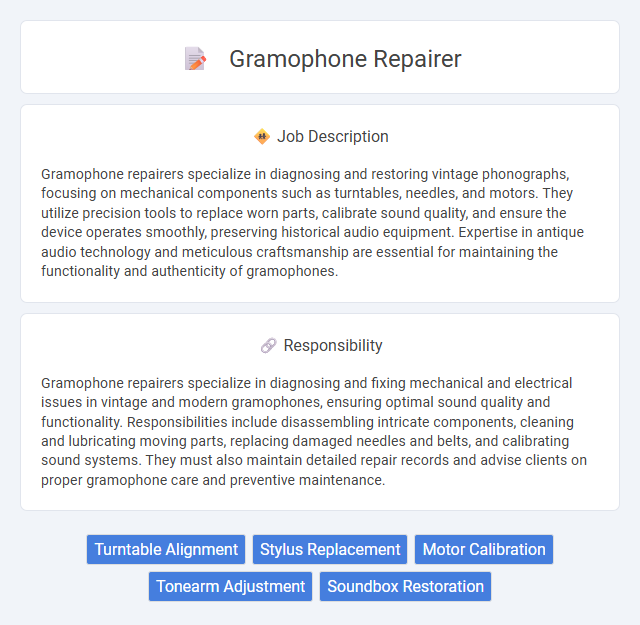
Gramophone repairers specialize in diagnosing and restoring vintage phonographs, focusing on mechanical components such as turntables, needles, and motors. They utilize precision tools to replace worn parts, calibrate sound quality, and ensure the device operates smoothly, preserving historical audio equipment. Expertise in antique audio technology and meticulous craftsmanship are essential for maintaining the functionality and authenticity of gramophones.
Individuals with strong attention to detail and patience are likely well-suited for gramophone repair roles, given the precision required for delicate mechanical and electronic components. Those who enjoy hands-on work and problem-solving may find this job rewarding, though people with limited manual dexterity or low tolerance for meticulous tasks might face challenges. A passion for vintage technology or historical audio equipment could increase one's probability of thriving in this occupation.
Qualification
A gramophone repairer requires strong technical knowledge of vintage audio equipment and expertise in mechanical and electrical components repair. Proficiency in diagnosing faults, soldering, and restoring delicate parts is essential, along with experience using specialized tools for gramophone maintenance. Formal training in electronics or mechanical engineering, combined with hands-on experience in audio restoration, significantly enhances qualification for this role.
Responsibility
Gramophone repairers specialize in diagnosing and fixing mechanical and electrical issues in vintage and modern gramophones, ensuring optimal sound quality and functionality. Responsibilities include disassembling intricate components, cleaning and lubricating moving parts, replacing damaged needles and belts, and calibrating sound systems. They must also maintain detailed repair records and advise clients on proper gramophone care and preventive maintenance.
Benefit
A gramophone repairer likely enjoys the benefit of preserving vintage audio technology, which can provide a unique sense of fulfillment and cultural appreciation. There is probably a steady demand for specialized skills, potentially leading to consistent work and client loyalty. Expertise in this niche field may also open opportunities for higher rates compared to general electronic repair services.
Challenge
Gramophone repairer roles often involve diagnosing complex mechanical and electrical issues in vintage audio equipment, requiring a high level of precision and patience. The probability of encountering rare or obsolete parts can present significant challenges, necessitating creative sourcing or fabrication solutions. Skillful repairers may need to balance preserving original components while ensuring functionality, making the job both technically demanding and intellectually stimulating.
Career Advancement
Gramophone repairers possess specialized skills in restoring and maintaining vintage audio equipment, providing a unique niche in the audio restoration industry. Career advancement opportunities include progressing to roles such as vintage electronics specialist, technical trainer, or workshop manager, leveraging expertise to lead teams or conduct specialized training sessions. Mastery in repairing diverse audio devices also opens pathways to collaboration with museums, collectors, and audio preservation organizations.
Key Terms
Turntable Alignment
Gramophone repairers specialize in precise turntable alignment to ensure optimal audio playback quality and longevity of vintage records. Accurate calibration of the tonearm height, cartridge position, and platter speed is essential for reducing tracking errors and minimizing record wear. Mastery in turntable alignment combines mechanical expertise with a deep understanding of analog sound systems to restore authentic sound fidelity.
Stylus Replacement
Gramophone repairers specialize in maintaining vintage audio devices, ensuring optimal performance through precise stylus replacement. The stylus, a critical component that reads record grooves, requires careful handling to prevent damage and preserve sound quality. Expert knowledge in identifying compatible stylus types and performing accurate installations is essential for prolonging the lifespan of classic gramophones.
Motor Calibration
Motor calibration in gramophone repair ensures precise alignment and optimal speed control of the rotating components, crucial for accurate playback. Technicians utilize specialized tools and diagnostic equipment to adjust and synchronize the motor's RPM, preventing pitch distortion and mechanical wear. Consistent motor calibration enhances sound quality and prolongs the lifespan of vintage gramophones.
Tonearm Adjustment
Tonearm adjustment in gramophone repair involves precisely calibrating the arm to ensure optimal tracking and minimal record wear. Proper alignment enhances sound quality by maintaining accurate needle pressure and preventing skips or distortions. Skilled repairers use specialized tools to fine-tune the tonearm's height, azimuth, and anti-skate settings for flawless playback performance.
Soundbox Restoration
Soundbox restoration is a critical task in gramophone repair, involving the delicate refurbishment of the acoustic diaphragm to ensure optimal audio fidelity. Repairers meticulously replace or mend the thin mica or aluminum sheets within the soundbox, restoring the clarity and volume of sound output. Precision in this process is essential to maintain the authentic vintage tone and functionality of antique gramophones.
 kuljobs.com
kuljobs.com